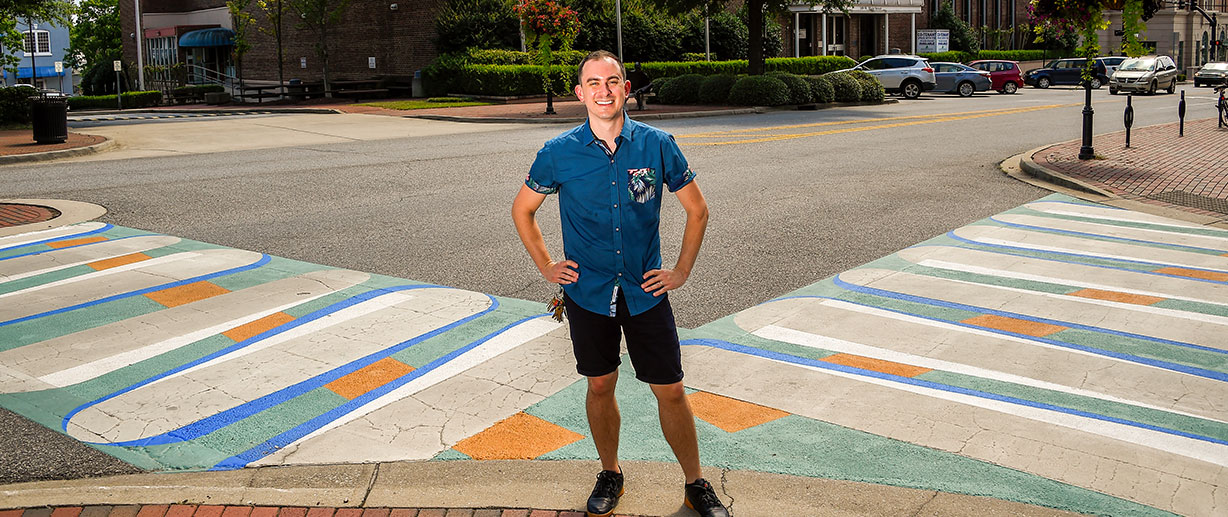SPARTANBURG, S.C. – Strolling in downtown Spartanburg these days is an artistic adventure thanks to four local artists, including Michael Webster, assistant professor of studio art at Wofford College, whose artwork adorns the crosswalks at West Main and King streets.
Webster was among teams selected to participate in the Creative Crosswalk Public Art Project conceived by the Chapman Cultural Center in Spartanburg. Artists created and painted designs at three intersections of West Main Street and King, Spring and Magnolia streets.
Matthew Donaldson, a University of South Carolina Upstate professor, and a team of artists Frankie Page, aka Frankie Zombie, and Adrian Meadows, aka IIAspire, did the work on the other two intersections.
“From start to finish, it took about 20 hours in one day,” says Webster, who was assisted with his project by Wofford senior Micah Tiffin, a senior sociology and anthropology major with a minor in studio arts from Greenville, S.C., along with Dr. Youmi Efurd, curator of Wofford’s galleries; Dr. David Efurd, associate professor in the Department of Art and Art History; and Webster’s wife, Ashley Gilreath. “Needless to say, I was exhausted and sore after the mural was complete. It was back-breaking work, and I appreciate all of their help.” He adds that Wofford junior Jeremy Powers, a finance major from Spartanburg, who has a video and photography studio called Sky Shutter Media, used his drone for aerial photos of the finished product.
Those 20 hours don’t take into account Webster’s 40 hours of design work that included measuring the crosswalk accurately, sketching dozens of design ideas, tweaking his early ideas, then rendering the best three designs in Photoshop and submitting his favorite – which was approved.
In all his designing, Webster, who has an MFA in sculpture from the School of the Art Institute of Chicago, had to find a way to incorporate the existing white bars in the crosswalk “in a way that was cohesive and allowed for the design to have a sense of wholeness. I also wanted to privilege the pedestrian experience over the experience of the motorist by generating visual energy and movement for the pedestrian.”
Knowing that the existing white bars of the crosswalk had to remain, Webster found a way to integrate them into the design. “I found that rounding the ends of the bars allowed those existing shapes to appear purposeful and planned, rather than a disruptive element incorporated by necessity,” he says. “I also used white paint to slightly extend those bars into wedges to create visual movement and reverberation. Blue ‘shadows’ around the white shapes imbue a slight sense of depth and pop of color. The background seafoam matches the copper patina on the awning of the nearby Masonic Temple building. Lastly, mustard yellow bars run diagonally across the crosswalk, mimicking the shape of the original crosswalk bars gone awry.
“All of these decisions came from navigating the site requirements,” he adds, “responding to the context of the built environment, and privileging the experience of movement for the pedestrian over that of the motorist.”
Webster, who says his work “investigates the social organization of space,” was glad to be part of a public art project in Spartanburg, he says. “Public art projects that are highly visible in the city are indicators of a larger active cultural community. Visitors to Spartanburg might not see all of the visual and performing artists that are working to make Spartanburg an arts destination, but public art is evidence that there is support for a vibrant, culturally engaged city,” he says. “Public art also provides an opportunity to imagine our public spaces as engaging in unexpected ways. The act of walking across the street can become a heightened sensory experience instead of background noise between destinations.”
It's exactly the purpose of the project, says Christopher George, the city’s communications manager. “This project provides a unique way to both show off the incredible artistic creativity that exists in the Spartanburg community and enhance downtown walkability, both of which are enormously important goals for our city. Our robust, diverse local arts scene is one of the most important ways Spartanburg sets itself apart as a city, and these vibrant and inspired crosswalk murals are a fantastic addition to our Downtown Cultural District.”
Jennifer Evins, president and CEO of the Chapman Cultural Center, adds that the Creative Crosswalk Public Art Project allows art to be a part of everyday life in downtown and shows how the arts can play a role in important issues such as public safety.
Webster, whose site-specific art projects include Chicago; Moorestown, N.J., Greenville, N.C.; and Talca, Chile, has moved on to another project – “collecting found bricks throughout Spartanburg, making silicone molds and casting copies of the bricks, and I’ve been learning bricklaying. I’m not sure where this material is leading, but I am beginning to imagine building new public spaces from a patchwork of lost bricks.”
